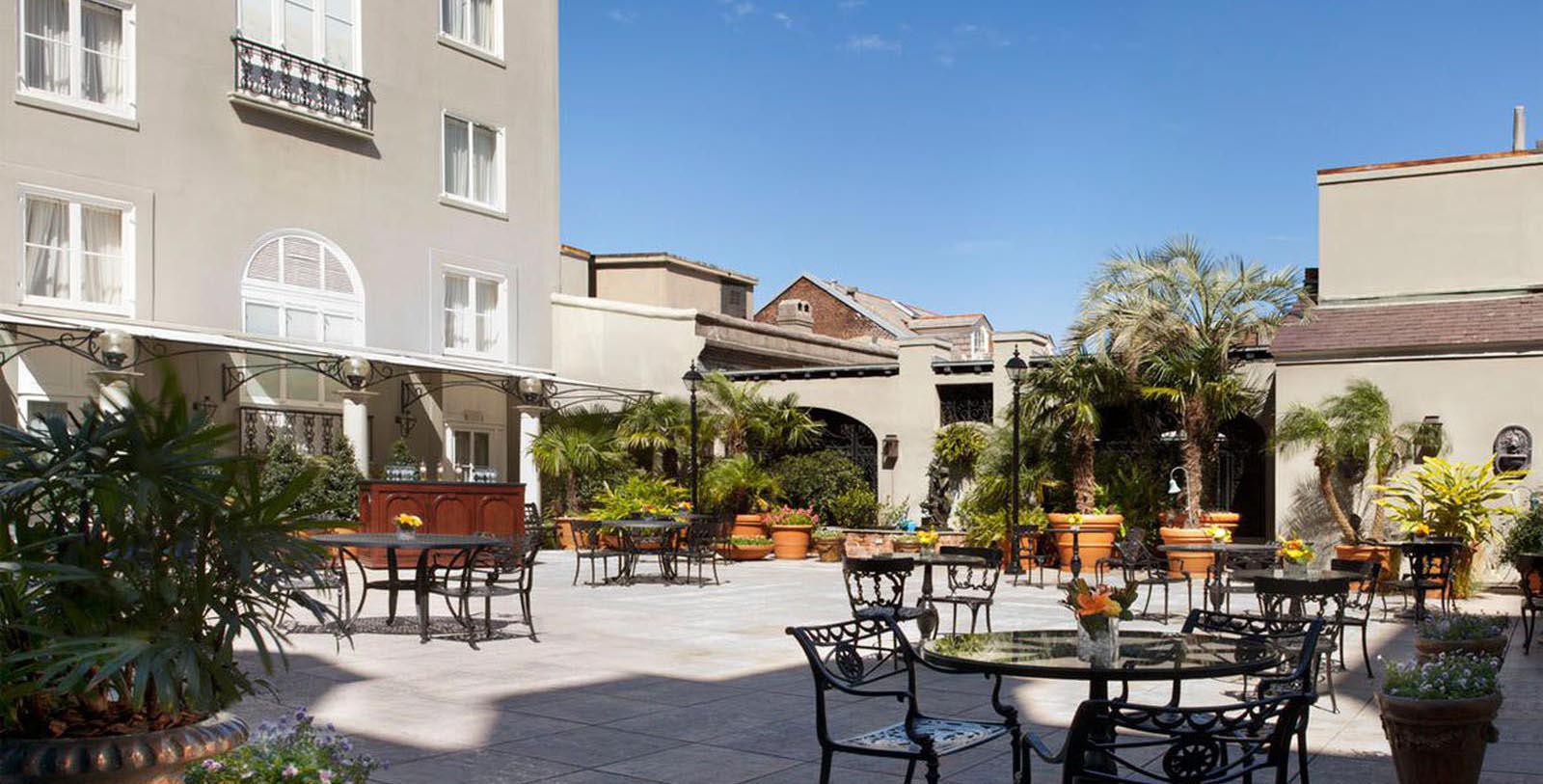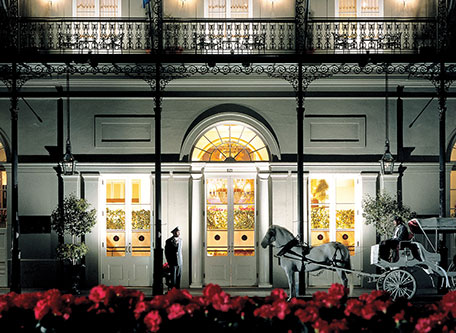Receive for Free - Discover & Explore eNewsletter monthly with advance notice of special offers, packages, and insider savings from 10% - 30% off Best Available Rates at selected hotels.
history
Discover the Omni Royal Orleans, which was once known as The City Exchange and the St. Louis Hotel.
Omni Royal Orleans, a member of Historic Hotels of America since 2010, dates back to 1843.
VIEW TIMELINEVery much like the City of New Orleans, the history of the Omni Royal Orleans is one marked by a triumphant struggle to overcome life’s many tribulations. The hotel itself harkens back to the early 19th century, when New Orleans was rapidly becoming one of the nation’s most important ports. Thousands of merchants moved their products into the city, given its relative location at the mouth of the Mississippi River. All sorts of steamboats and sailing ships docked in New Orleans’ bustling wharfs, delivering such goods like sugarcane and cotton. Yet, not all commerce was noble in nature, as the community was also deeply invested in the national slave trade. Dozens of auction houses operated within the city that saw the distribution of slaves throughout the American South. Among the places where slave trading occurred regularly was at The City Exchange, where many slaves were auctioned off to prospective buyers every week. This operation fortunately shutdown in the early 1830s, though, when aspiring hotelier James Hewlett decided to use the location for the site of a grand hotel.
Hewlett, a Creole descended from the city’s black and French populations, had long yearned to own a magnificent holiday destination that would rival the St. Charles Hotel in its eloquence. He hoped that this facility would provide a meeting place for people of all backgrounds to congregate and relax. Hewlett broke ground on the project in 1838, recruiting architect Jacques Nicholas Bussiere De Poilly to oversee the project. De Poilly had been specifically tasked with recreating the sophisticated aura of Paris’ Rue de Rivoli inside the building. Called the “St. Louis Hotel,” it took the two men five years to complete. Part of the delay was the result of a massive fire that compromised the entire layout of the building. Crestfallen, Hewlett and De Poilly had to start rebuilding the structure nearly from scratch. But when the hotel finally opened in 1843, it stood as one of the most glorious buildings in downtown New Orleans. Its opening ceremony was attended by some 600 guests who quickly scattered throughout the hotel’s three luxurious floors.
The St. Louis Hotel maintained its status as one of the city’s most exclusive retreats during the mid-19th century, with some of the most extravagant Mardi Gras ceremonies held inside its spectacular ballrooms. But the outbreak of the American Civil War brought this era of prosperity to a dramatic end. New Orleans’ strategic location along the Gulf Coast made it an immediate target for both the Union and Confederate militaries, which rendered the city a battleground almost as soon as the conflict started. The hotel did not escape this fate, as it was requisitioned by the Union in early 1862 for use as a military hospital. Local politicians then acquired the hotel during Reconstruction with the intent on transforming it into the state’s temporary capitol while they established a provisional government. The State of Louisiana soon decided to reopen the building as a hotel and leased it to various entrepreneurs. None of these hoteliers managed to turn a profit, though. The hotel languished and ultimately closed its doors in 1912. This period of decline was only made worse when a powerful hurricane slammed into New Orleans some three years later, which greatly damaged the building.
After World War II, a group of individuals led by Edith and Edgar Stern started to discuss the prospect of renovating the St. Louis Hotel as part of a large push to revitalize the entire French Quarter. After nearly a decade of deliberations, the Sterns and their allies were finally ready to finance the construction project. They hired architects Arthur Davis and Samuel Wilson Jr., to fully rehabilitate both the interior and exterior layout of the St. Louis Hotel. What Davis and Wilson managed to achieve was nothing short of miraculous, as they fully recreated the building’s grand Renaissance Revival-style architecture. Debuting once again in 1960, the hotel quickly resumed its place as one of the city’s great Grand Dames. It attracted many famous celebrities and politicians, including Muhammad Ali, Paul Newman, and even Lassie the dog. The Stern family eventually sold the location to Aetna in 1980, which in turn, transferred it to the Sonesta Corporation. Omni Hotels and Resorts then acquired the lease in 1986, operating the hotel as the “Omni Royal Orleans.” Today, the Omni Royal Orleans is jointly operated by Omni Hotels and Resorts as well as team of local investors. A member of Historic Hotels of America since 2010, the Omni Royal Orleans is still a place to see and be seen in downtown New Orleans.
-
About the Location +
The Omni Royal Orleans is located in the heart of the Vieux Carré, otherwise known more popularly as the French Quarter. A National Historic Landmark, the French Quarter was first established in 1718 by French colonials under the direction of the Mississippi Company. These aspiring settlers were specifically led to the region by Jean-Baptiste Le Moyne de Bienville, who would go on to serve as the local colonial governor throughout much of the early 18th century. The French Crown intended for the nascent settlement to operate as an important regional port that controlled trade throughout the Mississippi Delta. After navigating the local coastline for several weeks, Bienville and his compatriots found a section of high ground above the Mississippi River that offered natural protection from flooding waters, as well as incursions against English and Spanish privateers. They named their new community “La Nouvelle-Orléans” in honor of the Duke of Orleans, a nephew of King Louis XIV.
La Nouvelle-Orléans eventually evolved into New Orleans, the capital of the French colony of Louisiana. France lost control over the city for a time during the late 18th century, when the French were forced to cede the colony to the Spanish following the Seven Years War. Yet, the Spanish gave New Orleans back to the French in 1800 at the height of the Napoleonic Wars. The town and the surrounding parishes were then part of the Louisiana Purchase, in which Emperor Napoléon Bonaparte sold 828,000 square miles of French-controlled territory in central North America to U.S. President Thomas Jefferson. The city subsequently became the capital for the new state of Louisiana in 1812, rapidly evolving into the most important port in the southern United States. This growth was offset temporarily with the outbreak of the War of 1812, with New Orleans itself becoming a battleground. It was the site of the famous Battle of New Orleans, where future president Andrew Jackson defeated the British in an incredibly lopsided victory.
New Orleans’ significance as a commercial port made it a highly valuable strategic point of interest for both the Union and Confederacy during the American Civil War. Both armies fought over the city early in the war, with the United States Navy forcing local Confederate units from the area in early 1862. It subsequently became the base for future operations by the Union in the Mississippi Delta for the duration of the conflict. Following the cessation of hostilities between the two sections in 1865, New Orleans resumed its national status as a premier port city. It even served as an integral part to the national war effort in World War II, where it became the site for the development of the crucial Higgins Boat. New Orleans has since emerged as one of the nation’s most popular tourist destinations, with millions visiting every year. The most popular attraction is the original French Quarter and its celebrated landmarks, such as Jackson Square, St. Louis Cathedral, and Bourbon Street. All of these fantastic sites wonderfully represent the original French heritage of the Vieux Carré.
-
About the Architecture +
The current iteration of the Omni Royal Orleans displays some of the finest Renaissance Revival-style architecture in all of New Orleans. Renaissance Revival architecture—sometimes referred to as "Neo-Renaissance”—is a group of architecture revival styles that date back to the 19th century. Neither Grecian nor Gothic in their appearance, Renaissance Revival-style architecture drew inspiration from a wide range of structural motifs found throughout Early Modern Western Europe. Architects in France and Italy were the first to embrace the artistic movement, who saw the architectural forms of the European Renaissance as an opportunity to reinvigorate a sense of civic pride throughout their communities. As such, those intellectuals incorporated the colonnades and low-pitched roofs of Renaissance-era buildings, with the characteristics of Mannerist and Baroque-themed architecture. Perhaps the greatest structural component to a Renaissance Revival-style building involved the installation of a grand staircase in a vein similar to those located at the Château de Blois and the Château de Chambord. This particular feature served as a central focal point for the design, often directing guests to a magnificent lobby or exterior courtyard. Yet, the nebulous nature of Renaissance Revival architecture meant that its appearance varied widely across Europe. As such, historians today often find it difficult to provide a specific definition for the architectural movement.
-
Famous Historic Guests +
Louis Armstrong, renowned Jazz musician regarded as one of the most influential figures in the genre.
Patti LaBelle, singer and songwriter often referred to today as the “Godmother of Soul.”
Luciano Pavarotti, one of the most famous Italian opera singers of the 20th century.
Bette Davis, actress known for her roles in All About Eve, Jezebel, and What Ever Happened to Baby Jane?
Charlton Heston, actor known for his roles in such movies like Ben-Hur, El Cid, and Planet of the Apes.
Paul Newman, actor known for his roles in such films like Cool Hand Luke, The Sting, and Butch Cassidy and the Sundance Kid.
Robert Redford, actor known for such roles in Out of Africa, All the President’s Men, and Butch Cassidy and the Sundance Kid.
Muhammad Ali, professional boxer and political activist regarded as one of the greatest athletes of the 20th century.
David Brinkley, longtime news anchor for NBC and ABC, whose career lasted from 1943 to 1997.
Richard Nixon, 37th President of the United States (1969 – 1974)
Lassie, a Rough Collie dog who served as the main character in the television series, Lassie.
-
Film, TV and Media Connections +
Live and Let Die (1973)































